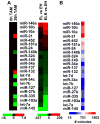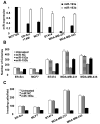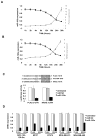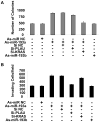Inhibition of miR-193a expression by Max and RXRα activates K-Ras and PLAU to mediate distinct aspects of cellular transformation
- PMID: 21670079
- PMCID: PMC3148313
- DOI: 10.1158/0008-5472.CAN-11-0425
Inhibition of miR-193a expression by Max and RXRα activates K-Ras and PLAU to mediate distinct aspects of cellular transformation
Abstract
MicroRNA profiling in isogenic models of cellular transformation involving either breast epithelial cells or fibroblasts reveals that expression of miR-193a is lower in transformed cells than in nontransformed cells. The transcription factors Max and RXRα bind directly to the miR-193a promoter and inhibit miR-193a expression during transformation. miR-193a inhibits cellular transformation by directly targeting the 3' untranslated regions of PLAU and K-Ras. Interestingly, miR-193a controls anchorage-independent growth in soft agar through K-Ras, whereas it affects invasive growth through PLAU. miR-193a overexpression inhibits the tumorigenicity of developmentally diverse but not all cancer cell types, and it inhibits tumor growth in colon- and breast-derived xenografts. Finally, expression of miR-193a is inversely correlated with PLAU and K-Ras in human colon adenocarcinomas. Thus, a pathway in which Max and RXRα inhibit miR-193a expression, thereby activating the PLAU and K-Ras oncogenes is important for distinct aspects of cellular transformation, as well as tumor growth and colon (and perhaps other types of) cancer.
Figures







References
-
- Soule HD, Maloney TM, Wolman SR, Peterson WD, Brenz R, McGrath CM, et al. Isolation and characterization of a spontaneously immortallized human breast epithelial cell line, MCF10. Cancer Res. 1990;50:6075–86. - PubMed
Publication types
MeSH terms
Substances
Grants and funding
LinkOut - more resources
Full Text Sources
Other Literature Sources
Miscellaneous

